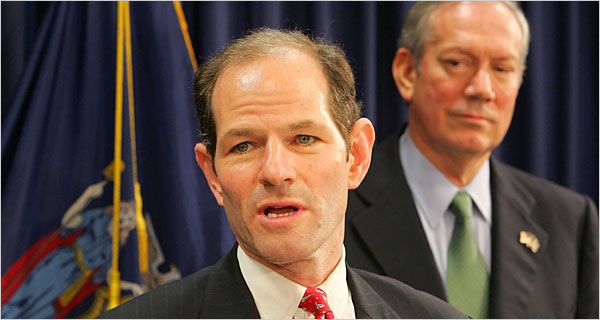|
|
Pataki and Spitzer Back
Downsizing of Hospitals
By Richard Pérez-Peña, The New York Times
November 30, 2006

Gov. George E. Pataki and Governor-elect Eliot Spitzer yesterday endorsed a plan to close or shrink dozens of hospitals and nursing homes across the state. Their support means that it will be up to the Legislature to decide whether to block the proposed downsizings.
Despite strenuous protests from some legislators whose districts include the affected institutions, lawmakers and top aides in both the Senate and the Assembly said that even before the current and future governors spoke out, the prevailing sense in Albany was that the Legislature — the Republican-controlled Senate, in particular — would not stand in the way of the proposed changes.
But they stressed that the political situation was still very fluid. In particular, they said, legislators could move against the proposal if the powerful health care workers’ union, 1199 S.E.I.U. United Healthcare Workers East, and the major hospital associations decided to oppose it.
So far, the hospital groups and the union have reserved judgment, as have the Senate majority leader, Joseph L. Bruno, and Assembly Speaker Sheldon Silver.
On Tuesday, the Commission on Health Care Facilities in the 21st Century released the plan, a result of more than a year of study, recommending the elimination of about 20 hospitals through closings, mergers and conversions to other uses.
The commission said that dozens of other hospitals should decrease in size, drop some departments or take on new functions. In addition, it recommended closing or shrinking a smaller number of nursing homes.
Under the law that created the commission, its plan will become law unless the governor or the Legislature rejects it in its entirety; they cannot consider it piecemeal. Of course, lawmakers could return next year and pass a new law that negates the old one and allows them to pick and choose among the recommendations, but that is considered unlikely, particularly under a new governor who has endorsed the plan.
“The commissioners did an outstanding job,” Mr. Pataki, who was traveling in Kuwait, told reporters yesterday via a satellite link. He said the commission “made some tough recommendations but necessary recommendations,” and that adopting the report is “the right thing for New York’s health care community.”
Mr. Spitzer released a statement saying that he might disagree with some of the proposals, but that he embraced the plan as a whole. He added, “If the Legislature allows these recommendations to become law, as I believe they must, my administration will have the responsibility for implementing them.”
The Legislature can block the plan only if both houses vote it down by Dec. 31. If it does not, the plan will take effect on Jan. 1, the day Mr. Spitzer, a Democrat, takes office.
Richard N. Gottfried, the Democratic chairman of the Assembly Health Committee, said that he and many of his colleagues were particularly concerned about the commission’s plans to merge public institutions — two hospitals in Buffalo and Syracuse, and several upstate nursing homes — with private ones, removing them from government control.
As for the report as a whole, he said, “It is nowhere near as bad as it could have been, but in some communities, the recommendations will create real problems.” He said he had not yet taken a position on the recommendations, and would not guess what might happen, though he said Mr. Spitzer’s endorsement would carry some weight in the Assembly.
Those legislators and aides who were more willing to make predictions and repeat internal discussions were granted anonymity, because they said they risked the wrath of Mr. Bruno or Mr. Silver for speaking out before the leaders did, and for prejudging the outcome.
A large contingent of the Assembly’s Democratic majority met yesterday to discuss the commission’s report. People who attended the meeting said that relatively few members spoke decisively against the plan, but even fewer spoke in its favor.
Perhaps predictably, the debate has so far turned largely on the parochial concerns of politicians and interest groups long accustomed to defending the institutions in their districts at all costs. “If you’ve got a hospital or nursing home closing in your district, you hate it, but that’s not true of most of us,” said one Assembly Democrat.
A Senate Republican said, “So far, there’s some brush fires, people saying we have to oppose this, but it’s not a forest fire, and my guess is it doesn’t become one.”
The strongest opposition is coming from the Buffalo-Niagara Falls area, which would have the largest number of closings and consolidations relative to its size. But some Senate officials noted that most of the affected hospitals and nursing homes are in Democratic senators’ districts, possibly lessening the chances of opposition from the Republican majority.
Mr. Pataki and the Legislature created the commission last year in response to a string of hospital closings and bankruptcies, seeking a plan to stabilize an industry that was widely seen as bloated and inefficient.
Industry officials noted that the plan created winners as well as losers; surviving institutions would gain business from the closing or shrinking of nearby competitors.
There are two prime examples in Manhattan, where Beth Israel Medical Center stands to benefit from the closing of Cabrini Medical Center a few blocks away, and Roosevelt Hospital could take in much of the business that has gone to St. Vincent’s Midtown Hospital, which is also marked to close. Roosevelt and Beth Israel are part of the same corporation, Continuum Health Partners.
Michael Cooper, in Albany, contributed reporting.
|
|



